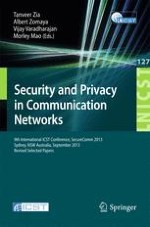2013 | Buch
Security and Privacy in Communication Networks
9th International ICST Conference, SecureComm 2013, Sydney, NSW, Australia, September 25-28, 2013, Revised Selected Papers
herausgegeben von: Tanveer Zia, Albert Zomaya, Vijay Varadharajan, Morley Mao
Verlag: Springer International Publishing
Buchreihe : Lecture Notes of the Institute for Computer Sciences, Social Informatics and Telecommunications Engineering
